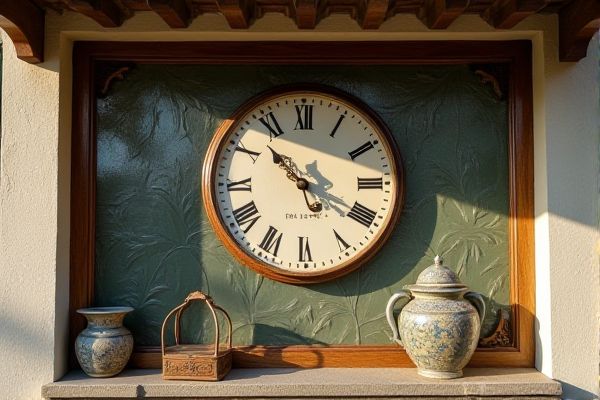
An outdoor clock provides precise timekeeping regardless of weather or daylight, while a sundial relies on the sun's position and ceases to function at night or on cloudy days. Discover which option suits your needs best by reading the rest of the article.
Table of Comparison
| Feature | Outdoor Clock | Sundial |
|---|---|---|
| Time Accuracy | High; precise timekeeping using quartz or digital mechanisms | Variable; time indicated depends on sunlight and gnomon angle |
| Operation | Works 24/7, day and night | Works only in daylight, requires direct sunlight |
| Power Source | Battery or electric powered | No power source needed; purely mechanical and solar |
| Weather Dependency | Operates in all weather conditions | Cannot function during cloudy or rainy weather |
| Design | Modern or traditional clock designs, visible face with hands or digital display | Typically stone or metal with a gnomon casting shadow |
| Maintenance | Requires occasional battery replacement or servicing | Minimal; cleaning and repositioning occasionally |
| Installation | Mounted on walls, poles, or stands anywhere outdoors | Fixed placement aligned with Earth's axis for accuracy |
| Cost | Ranges from inexpensive to costly based on technology | Usually low cost but custom sundials can be expensive |
Introduction to Outdoor Timekeeping
Outdoor clocks provide accurate timekeeping using mechanical or electronic mechanisms, making them reliable regardless of weather or sunlight conditions. Sundials, one of the oldest timekeeping methods, rely on the sun's position to cast shadows, offering a natural and decorative way to track time during daylight hours. While outdoor clocks ensure precision and functionality around the clock, sundials serve as historical and aesthetic outdoor timepieces that connect viewers to the movement of the sun.
What Is an Outdoor Clock?
An outdoor clock is a timekeeping device designed for exterior placement, often featuring weather-resistant materials and large, easy-to-read dials for visibility from a distance. Unlike sundials, which rely on the position of the sun to indicate time, outdoor clocks use mechanical or electronic movements powered by batteries, electricity, or solar energy to display accurate time regardless of lighting or weather conditions. These clocks are commonly used in gardens, public spaces, and building facades to provide precise timekeeping throughout the day and night.
Understanding the Sundial
A sundial uses the position of the sun's shadow cast by a gnomon to indicate time, relying on Earth's rotation and sunlight, making it effective only during daylight hours. Unlike an outdoor clock that provides precise, continuous timekeeping regardless of weather or light, a sundial offers a historical, natural method to read time linked closely to solar movement. Your understanding of the sundial highlights its role as both a functional timepiece and an educational tool demonstrating the connection between time and the sun's position.
Historical Significance of Sundials
Sundials hold immense historical significance as one of the earliest timekeeping devices used by ancient civilizations, relying on the sun's shadow to indicate the hour. Outdoor clocks, in contrast, represent advancements in technology with mechanical and digital precision, providing accurate time regardless of sunlight. Understanding the historical importance of sundials enhances your appreciation of outdoor clocks as modern successors in the evolution of measuring time.
Modern Appeal of Outdoor Clocks
Outdoor clocks offer a modern appeal with precise timekeeping and stylish designs that complement any garden or patio space. Unlike sundials, which rely on sunlight and historical charm, outdoor clocks provide accurate time regardless of weather or lighting conditions. Enhance your outdoor living area with a functional timepiece that blends technology and aesthetics for a contemporary look.
Accuracy: Outdoor Clock vs. Sundial
Outdoor clocks provide precise and consistent timekeeping throughout the day, unaffected by weather conditions or the position of the sun. Sundials rely on the sun's position, making their accuracy dependent on clear skies and proper alignment with geographic location. Your choice between the two hinges on whether you prioritize modern accuracy or the historical and aesthetic appeal of sundials.
Aesthetic Considerations for Gardens
Outdoor clocks offer precise timekeeping and often feature intricate designs that complement various garden styles, from rustic to contemporary, enhancing visual interest while maintaining functionality. Sundials provide a classic, timeless aesthetic rooted in ancient tradition, creating a focal point with their sculptural form and the natural interaction of shadows with sunlight. Both elements can elevate garden decor, but sundials emphasize organic beauty and historical charm, whereas outdoor clocks blend modern practicality with ornamental appeal.
Installation and Maintenance Differences
Outdoor clocks offer straightforward installation with mounting brackets or stakes, requiring minimal maintenance such as battery replacements and occasional cleaning. Sundials demand precise placement based on geographic location and orientation for accurate time-telling, with maintenance focused on weathering and seasonal adjustments. Choosing between the two depends on whether You prefer easy setup and upkeep or authentic, sun-based time measurement.
Eco-Friendliness and Sustainability
Outdoor clocks powered by batteries or solar energy provide eco-friendly timekeeping solutions with minimal environmental impact. Sundials rely entirely on natural sunlight, requiring no energy consumption, making them the most sustainable option for your garden or outdoor space. Choosing between the two depends on balancing convenience with a commitment to reducing your carbon footprint.
Choosing Between an Outdoor Clock and Sundial
Selecting between an outdoor clock and a sundial depends on accuracy needs, maintenance preferences, and aesthetic goals. Outdoor clocks offer precise timekeeping regardless of weather or lighting conditions, while sundials rely on sunlight and provide a timeless, decorative addition to gardens. Consider opting for a weather-resistant outdoor clock for reliability or a sundial for a solar-powered, eco-friendly, and historically rich time display.
 homyna.com
homyna.com